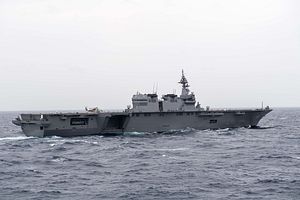Thinking about the British and Japanese experiences with anti-submarine warfare (ASW) is worthwhile for evaluating how modern navies have adapted to the same tasks. Philip Ramirez argues that that the structure of civil-military relations is key to understanding how navies think about ASW, or at least it was in context of the major anti-commerce campaigns of World War II. ASW remains a core task for modern navies, and of course structures of civil-military relations continue to matter a great deal for how military organizations prepare for tasks. How have these dynamics played out in the biggest navies in East Asia?
For its part, Japan’s adaptation to anti-submarine warfare was overdetermined. The Imperial Japanese Navy’s failure to successfully grapple with ASW had obvious implications for the post-war development of the Japanese Maritime Self-Defense Force (JMSDF). For one, Japan’s national security community became acutely aware of its vulnerability to submarine campaigns, a vulnerability accelerated by the decision of both the Soviet Union and the People’s Republic of China to invest heavily in submarines. For another, ASW was also a perfect fit for the constitutionally imposed defensive writ of the JMSDF, which could not engage in offensive operations. A focus on ASW, requiring mostly small vessels, also worked well with Japan’s limited military resources in the post-war period. In the early Cold War, the only ships available to Japan were anti-submarine focused platforms transferred from the United States. Available resources, civilian oversight, and historical experience converged to make the JMSDF a top-notch anti-submarine force.
The Chinese People’s Liberation Army Navy (PLAN), for its part, has never had any experience with anti-submarine warfare. Not being dependent upon foreign trade, and with only a minimal surface fleet, the PLAN did not need to invest much in the way of anti-submarine warfare during its early years, especially before the advent of submarine launched cruise missiles made the boats a conventional warfighting threat. Especially early in its history, the PLAN modeled itself around the Soviet Navy, but the Soviets themselves had little if any experience with fighting against submarines. Only after the Sino-Soviet Split, when the Soviet surface fleet began to expand significantly, did the USSR devote real resources to ASW.
But as the blue water tasks of the PLAN have increased, it has devoted greater resources and attention to the anti-submarine mission. As Rick Joe has detailed, the PLAN has extensively developed its anti-submarine capabilities over the past 10 years. This includes air, surface, and subsurface systems to hunt and kill U.S. and Japanese subs. The reasons for this may have something to do with the structure of civil-military relations in China, but it’s not obvious. The PLAN certainly lacks anything like the domination over Chinese politics that the IJN and the Imperial Japanese Army enjoyed over Japan. Moreover, the structure of the Chinese military is considerably different than that of Imperial Japan, with the overarching structure of the PLA enforcing peace between the land, air, and sea services. Consequently, the PLAN probably lacks the freedom that the IJN enjoyed to build its force structure around a strategic concept. On the other hand, there’s little evidence to suggest that the PLAN needed a push from civilian leaders, or that its recent interest in ASW has much to do with anything other than a reasonable assessment of new problems.
Thus, while the JMSDF developed its anti-submarine focus in an environment tightly constrained by politics and history, the PLAN has had greater, if still limited, freedom to find its own way. Another part of this story, perhaps, is that the experience of World War II irrevocably locked in the idea that anti-submarine warfare is a critical capability for any navy, and thus that naval professionals don’t need civilian direction to pay attention to the problem.

































